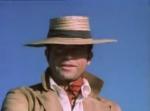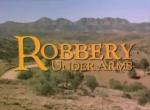AustLit

Latest Issues
AbstractHistoryArchive Description
Set in the late 1800s, Robbery Under Arms is the story of bushranger Captain Starlight, told from the perspective of young Dick Marsden. Dick and his brother Jim follow their father's footsteps, on the wrong side of the law. After they succumb to the impetuosity of a tossed coin and participate in the theft and subsequent sale of fifteen hundred head of cattle, the pair team up with the mysterious Starlight (the renegade son of a British noble family), and evolve from petty criminals to outlawed bushrangers, terrorising the countryside, often in partnership with their father Ben and Starlight's Aboriginal offsider Warrigal. Throughout this story, the brothers find themselves at odds with both their mother and sister and with the lives they could have otherwise led.
Notes
-
In taking his narrative perspective from one of the outlaws, Boldrewood exposes the emotions and actions of the Marsden brothers and Captain Starlight in a way that humanises their plight. even while they move from petty thieves to dangerous fugitives. Conversely, by limiting the narrative role of the police, and particularly Inspector Morringer, Boldrewood assigns the law-abiding characters the roles usually reserved for criminals.
-
Note on production:
The production of Robbery Under Arms was unusually complicated. In light of the expenses involved in the production, a film (two and a half hours) and a mini-series (six one-hour episodes) were filmed simultaneously.
Some sources suggest that the film was a cut-down version of the mini-series (as, for example, with the Escape from Jupiter television series, which was cut down to film length for video release).
Other sources suggest that two completely different scripts were prepared, one for the mini-series and one for the film.
Director Donald Crombie specified that it was something of a combination of both: according to Crombie, the film was created by cutting down segments of the miniseries and 'putting in the least amount of story. [We then edged] material back in until we were absolutely sure that it was the best story [we could tell] in the shortest time' (ctd. Sheila Johnston and Neil Roddick Cinema Papers May 1985, p. 58).
The production also used two directors, but both are credited on both film and mini-series.
Mini-series and film have been treated as separate works, but have a complicated relationship to one another.
Publication Details of Only Known VersionEarliest 2 Known Versions of
Works about this Work
-
Recalling Romance and Revision in the Film Adaptations of Robbery Under Arms and The Chant of Jimmie Blacksmith
2016
single work
criticism
— Appears in: Adaptation , March vol. 9 no. 1 2016; (p. 46-57) 'This paper interrogates the adaptation of two literary bushranger narratives to film during the Australian Film Revival in the 1970s and 1980s: The Chant of Jimmie Blacksmith (Fred Schepisi, 1978), an adaptation of Thomas Keneally’s 1972 novel of the same name, which itself was based on the true story of Jimmy Governor, and Donald Crombie and Ken Hannam’s 1985 adaptation of Rolf Boldrewood’s 1889 novel Robbery Under Arms, a text that has seen numerous other adaptations on both stage and screen. Analysis of these case studies demonstrates that the narratives’ ideological positions regarding Australia’s past can be understood in relation to the western genre, their narrative structures, selective deviations from their respective source materials, and the similitude of their bushranger characters to Graham Seal’s ‘outlaw legend’. I relate each film’s ideological stance on bushranging to its production context and argue that Robbery Under Arms depicts a romantic idealisation of Australian history that is closer to Alfred Dampier and Garnet Walch’s 1890 stage melodrama version than the original novel in its appeal to populist nationalism, while The Chant of Jimmie Blacksmith attempts a visual translation of the novel’s revisionist approach to bushranger and colonial legends.' (Publication abstract) -
y
 'Robbery Under Arms'
Perth
:
Centre for Research in Culture and Communication (Murdoch University)
,
2003
Z1609358
2003
single work
criticism
'Robbery Under Arms'
Perth
:
Centre for Research in Culture and Communication (Murdoch University)
,
2003
Z1609358
2003
single work
criticism
Research undertaken by a student of the Centre for Culture and Communication (Murdoch University) into the 1985 combined film and television adaptation of Robbery Under Arms. Includes aspects relating to the production phase, critical reception, principal performers and production crew, references and a synopsis.
-
y
 'Robbery Under Arms'
Perth
:
Centre for Research in Culture and Communication (Murdoch University)
,
2003
Z1609358
2003
single work
criticism
'Robbery Under Arms'
Perth
:
Centre for Research in Culture and Communication (Murdoch University)
,
2003
Z1609358
2003
single work
criticism
Research undertaken by a student of the Centre for Culture and Communication (Murdoch University) into the 1985 combined film and television adaptation of Robbery Under Arms. Includes aspects relating to the production phase, critical reception, principal performers and production crew, references and a synopsis.
-
Recalling Romance and Revision in the Film Adaptations of Robbery Under Arms and The Chant of Jimmie Blacksmith
2016
single work
criticism
— Appears in: Adaptation , March vol. 9 no. 1 2016; (p. 46-57) 'This paper interrogates the adaptation of two literary bushranger narratives to film during the Australian Film Revival in the 1970s and 1980s: The Chant of Jimmie Blacksmith (Fred Schepisi, 1978), an adaptation of Thomas Keneally’s 1972 novel of the same name, which itself was based on the true story of Jimmy Governor, and Donald Crombie and Ken Hannam’s 1985 adaptation of Rolf Boldrewood’s 1889 novel Robbery Under Arms, a text that has seen numerous other adaptations on both stage and screen. Analysis of these case studies demonstrates that the narratives’ ideological positions regarding Australia’s past can be understood in relation to the western genre, their narrative structures, selective deviations from their respective source materials, and the similitude of their bushranger characters to Graham Seal’s ‘outlaw legend’. I relate each film’s ideological stance on bushranging to its production context and argue that Robbery Under Arms depicts a romantic idealisation of Australian history that is closer to Alfred Dampier and Garnet Walch’s 1890 stage melodrama version than the original novel in its appeal to populist nationalism, while The Chant of Jimmie Blacksmith attempts a visual translation of the novel’s revisionist approach to bushranger and colonial legends.' (Publication abstract)




